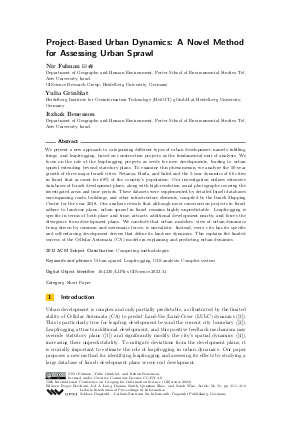Project-Based Urban Dynamics: A Novel Method for Assessing Urban Sprawl (Short Paper)
Authors Nir Fulman, Yulia Grinblat, Itzhak Benenson
-
Part of:
Volume:
12th International Conference on Geographic Information Science (GIScience 2023)
Part of: Series: Leibniz International Proceedings in Informatics (LIPIcs)
Part of: Conference: International Conference on Geographic Information Science (GIScience) - License:
 Creative Commons Attribution 4.0 International license
Creative Commons Attribution 4.0 International license
- Publication Date: 2023-09-07
File

PDF
LIPIcs.GIScience.2023.31.pdf
- Filesize: 2.14 MB
- 6 pages
Document Identifiers
Subject Classification
ACM Subject Classification
- Computing methodologies
Keywords
- Urban sprawl
- Leapfrogging
- GIS analysis
- Complex system
Metrics
- Access Statistics
-
Total Accesses (updated on a weekly basis)
0Document
0Metadata
Abstract
We present a new approach to categorizing different types of urban development, namely infilling, fringe, and leapfrogging, based on construction projects as the fundamental unit of analysis. We focus on the role of the leapfrogging projects as seeds for new developments, leading to urban sprawl extending beyond statutory plans. To examine this phenomenon, we analyze the 50-year growth of three major Israeli cities: Netanya, Haifa, and Safed and the 5-year dynamics of 66 cities in Israel that account for 68% of the country’s population. Our investigation utilizes extensive databases of Israeli development plans, along with high-resolution aerial photographs covering the investigated areas and time periods. These datasets were supplemented by detailed Israeli databases encompassing roads, buildings, and other infrastructure elements, compiled by the Israeli Mapping Centre for the year 2018. Our analysis reveals that although most construction projects in Israel adhere to land-use plans, urban sprawl in Israel remains highly unpredictable. Leapfrogging is specific in terms of both place and time, attracts additional development nearby, and forces the divergence from development plans. We conclude that urban modelers' view of urban dynamics being driven by common and systematic forces, is unrealistic. Instead, every city has its specific and self-enforcing development drivers that define its land-use dynamics. This explains the limited success of the Cellular Automata (CA) models in explaining and predicting urban dynamics.
Cite As Get BibTex
Nir Fulman, Yulia Grinblat, and Itzhak Benenson. Project-Based Urban Dynamics: A Novel Method for Assessing Urban Sprawl (Short Paper). In 12th International Conference on Geographic Information Science (GIScience 2023). Leibniz International Proceedings in Informatics (LIPIcs), Volume 277, pp. 31:1-31:6, Schloss Dagstuhl – Leibniz-Zentrum für Informatik (2023)
https://doi.org/10.4230/LIPIcs.GIScience.2023.31
BibTex
@InProceedings{fulman_et_al:LIPIcs.GIScience.2023.31,
author = {Fulman, Nir and Grinblat, Yulia and Benenson, Itzhak},
title = {{Project-Based Urban Dynamics: A Novel Method for Assessing Urban Sprawl}},
booktitle = {12th International Conference on Geographic Information Science (GIScience 2023)},
pages = {31:1--31:6},
series = {Leibniz International Proceedings in Informatics (LIPIcs)},
ISBN = {978-3-95977-288-4},
ISSN = {1868-8969},
year = {2023},
volume = {277},
editor = {Beecham, Roger and Long, Jed A. and Smith, Dianna and Zhao, Qunshan and Wise, Sarah},
publisher = {Schloss Dagstuhl -- Leibniz-Zentrum f{\"u}r Informatik},
address = {Dagstuhl, Germany},
URL = {https://drops.dagstuhl.de/entities/document/10.4230/LIPIcs.GIScience.2023.31},
URN = {urn:nbn:de:0030-drops-189267},
doi = {10.4230/LIPIcs.GIScience.2023.31},
annote = {Keywords: Urban sprawl, Leapfrogging, GIS analysis, Complex system}
}
Author Details
- Department of Geography and Human Environment, Porter School of Environmental Studies, Tel Aviv University, Israel
- GIScience Research Group, Heidelberg University, Germany
- Heidelberg Institute for Geoinformation Technology (HeiGIT) gGmbH at Heidelberg University, Germany
References
-
J. Almagor, I. Benenson, and N. Alfasi. Assessing innovation: Dynamics of high-rise development in an israeli city. Environment and Planning B: Urban Analytics and City Science, 45(2):253-274, 2018.

-
D. Broitman and D. Czamanski. Cities in competition, characteristic time, and leapfrogging developers. Environment and Planning B: Urban Analytics and City Science, 39(6):1105-1118, 2012.

-
Y. Chen, X. Li, X. Liu, and B. Ai. Modeling urban land-use dynamics in a fast developing city using the modified logistic cellular automaton with a patch-based simulation strategy. International Journal of Geographical Information Science, 28(2):234-255, 2014.

-
J. Portugali. Self-organizing cities. Futures, 29(4-5):353-380, 1997.

